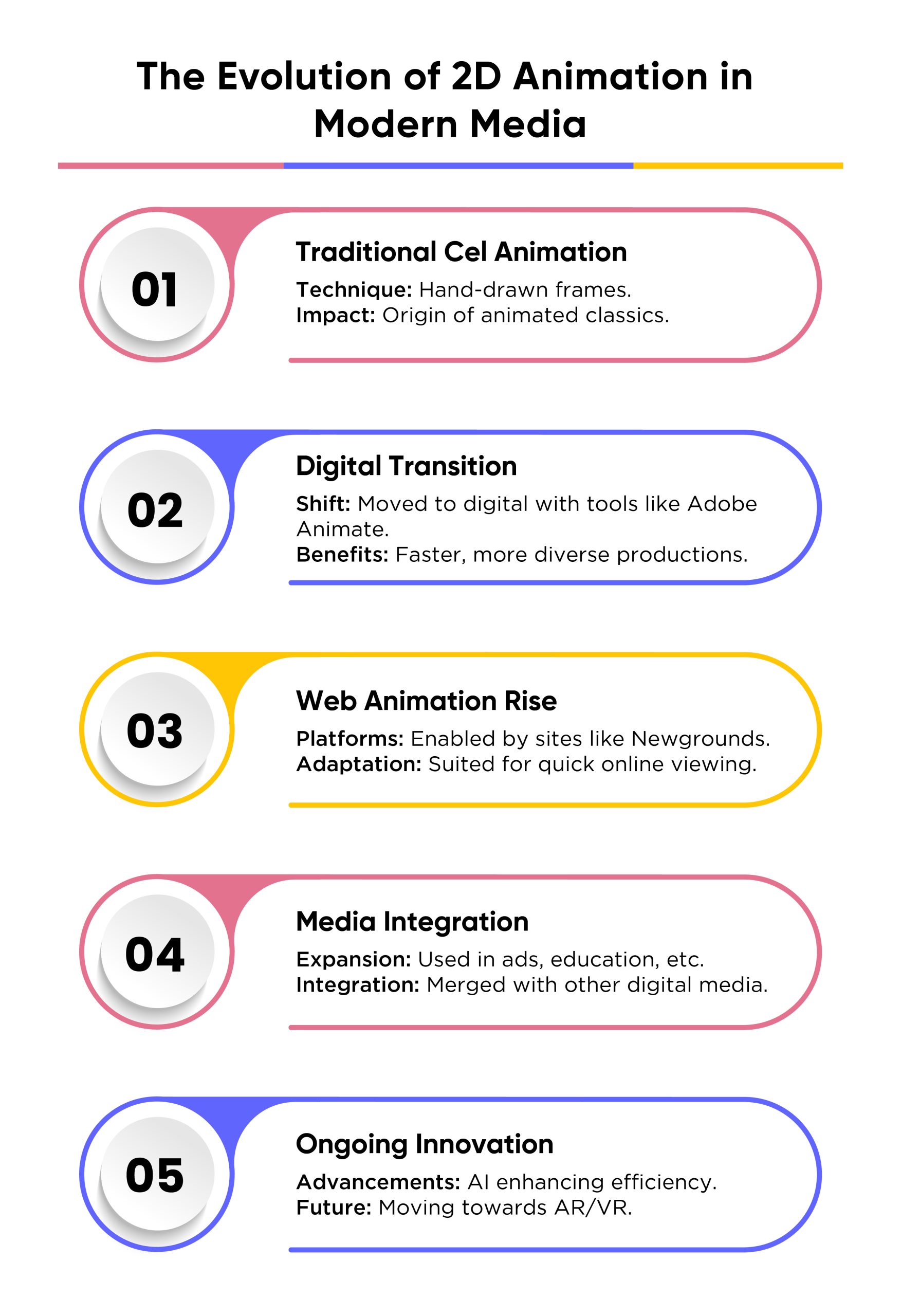Exploring Creative 2D Animation for Storytelling

Introduction For Creative 2D Animation for Storytelling
A fascinating media that gives stories life is 2D animation. From the old cartoons from our childhood to the current educational videos, 2D animation has developed into a versatile tool for both educators and artists. This Whimsitoons blog of “creative 2D animation for storytelling” looks at how to use imaginative 2D animation to better express your story and captivate your viewers.

Why Choose 2D Animation for Your Storytelling?
Not sure why you should create 2D animated explainer video?
Well, it is because 2D animation isn’t just about creating movement; it’s about conveying emotions and messages without the constraints of reality.
Here’s why it stands out:
- Simplicity: Unlike 3D, 2D animation is less complex in terms of production. This simplicity allows for quicker development and easier modification.
- Flexibility: You can experiment with various styles and aesthetics, from watercolor textures to crisp digital lines.
- Engagement: Animated stories can transform a simple message into an engaging experience, making it easier for viewers to absorb and remember information.
Exploring Creative 2D Animation Techniques
To create impactful animations, it’s crucial to combine artistic vision with technical skills. Here are some techniques to consider:
- Frame-by-Frame Animation: This traditional method, where each frame is drawn by hand, offers unmatched fluidity and a personal touch.
- Cut-out Animation: Utilizing flat characters and backgrounds cut from materials like paper, this technique allows for unique stylistic choices.
- Motion Graphics: Ideal for informational content, this style combines graphic design with animation to explain concepts clearly and attractively.
Each method has its charm and application, and choosing the right one depends on the story you want to tell and the emotions you wish to trigger.
Incorporating 2D Animation into Your Narratives
When planning your animation, consider these steps to integrate 2D techniques effectively, or collaborate with 2D art services for professional results.
- Scriptwriting: Start with a solid script that outlines your story flow and key messages.
- Storyboarding: Sketch the key scenes to visualize how your animation flows.
- Designing Characters and Environments: Create designs that reflect the personality of your characters and the tone of your story.
- Animation: Bring the drawings to life with motion, ensuring each frame aligns with the intended emotion and pacing.
- Sound Design: Choose or compose music and sound effects that complement the visual elements without overwhelming them.
By following these steps, you can create a seamless and engaging animated story.
Optimizing 2D Animations for Different Platforms
Creating a 2D animation isn’t just about crafting compelling visuals and narratives; it’s also about optimizing these animations to perform well across a variety of platforms. Each platform comes with its own set of rules, audiences, and best practices, which can influence how your animation should be presented. Here’s how you can ensure your 2D animations resonate and function effectively wherever they are viewed.
-
Understanding Platform Requirements
- Television: Traditional TV has strict broadcasting standards, including specific aspect ratios (usually 16:9) and broadcast-safe colors. Ensuring your animation meets these requirements is crucial to avoid any broadcast issues.
- Online Platforms (e.g., YouTube, Vimeo): These platforms prefer high-definition resolutions, such as 1080p or 4K. They also support a wider range of aspect ratios, from the traditional 16:9 to wider formats like 21:9 for cinematic effects.
- Social Media (e.g., Instagram, Twitter, Facebook): Social media platforms often favor shorter, more engaging content. Square (1:1) or vertical formats (9:16) are typically more effective on these platforms due to their mobile-first user base.
-
Adapting Content for Audience Engagement
Each platform not only has technical specifications but also different audience expectations:
- Television Viewers: Often engage with content more passively. Your animation should be designed to capture attention quickly, using bolder visuals and straightforward narratives.
- Online Audiences: Look for both entertainment and information. Your animations can be longer and more detailed, providing in-depth exploration of topics.
- Social Media Users: Prefer quick, impactful messages due to shorter attention spans when scrolling through feeds. Animations on these platforms should be concise, visually appealing, and designed to convey the message or trigger emotion quickly.
-
Technical Optimization
Optimizing your animation technically for each platform ensures smooth playback and high visual quality:
- Compression: High-quality compression settings are crucial to maintain visual integrity while minimizing file size for quick loading, especially important for online and mobile viewers.
- Frame Rate: While television typically requires a standard frame rate of 24 or 30 frames per second (fps), online platforms may allow for higher frame rates, which can be beneficial for fast-paced or highly detailed animations.
- Color Profiles: Different screens display colors differently; what looks good on a professional monitor might not look the same on a smartphone. Testing colors across different devices can help in maintaining visual consistency.
-
Testing and Feedback
Before finalizing your animation for distribution:
- User Testing: Show your animation to small focus groups or test audiences that reflect the demographics of your target viewers on each platform. Gather feedback on both the content and the technical presentation.
- Analytics: After launching your animation, use platform-specific analytics tools to measure engagement, viewer retention, and other metrics. This data can inform future animation projects, helping you better tailor your content to each platform’s audience.
Cost and Production Considerations
The cost of 2D animation per minute can vary widely, typically ranging from a few hundred to several thousand dollars, depending on the complexity and quality of the animation. Here’s a quick breakdown to consider:
| Complexity Level | Estimated Cost per Minute |
| Basic | $200 – $500 |
| Moderate | $500 – $1,500 |
| High | $1,500 – $5,000+ |
Understanding these costs can help you budget effectively and set realistic expectations for your animation project.
Short Story Animation Ideas to Inspire You
Looking for inspiration? Here are some short story animation ideas that can promote your creativity:
- A Day in the Life: Animate a day in the life of a unique character, like a street-smart cat or a wise old tree.
- Historical Reimagining: Tell a historical event from a new perspective, using vibrant animations to highlight lesser-known details.
- Futuristic Fantasy: Write a story set in a future society where surprising connections between technology and nature occur.
Each idea offers a canvas for your creativity, showcasing how 2D animation can transform simple stories into memorable animations.
Conclusion
Creative 2D animation for storytelling transcends simple visual art, serving as a powerful medium to trigger emotions and bring narratives to life across various platforms. This exploration has highlighted the diverse techniques available, such as frame-by-frame animation, cut-out animation, and motion graphics, each offering unique ways to engage audiences. Essential elements such as scriptwriting, storyboarding, character and environment design, and sound design are crucial in creating compelling animations that capture and maintain viewer interest. Additionally, adapting animations to meet the specific requirements of different platforms can significantly enhance their reach and impact. The potential for creativity within 2D animation is boundless, accessible to both novices and seasoned animators alike, emphasizing the importance of both technical skills and the ability to connect with audiences to create memorable storytelling experiences.
FAQs
Q 1: What software is best for beginners interested in 2D animation?
For beginners, software like Adobe Animate or Toon Boom Harmony offers user-friendly interfaces and comprehensive tools to start animating.
Q 2: How long does it take to produce a one-minute animation?
Production times can vary widely, but typically, a one-minute animation can take anywhere from two weeks to two months to complete, depending on complexity.
Q 3: Can 2D animation be integrated with live-action video?
Yes, 2D animation can be beautifully combined with live-action footage to create hybrid visuals that are both engaging and informative.
Q 4: What are some common mistakes to avoid in 2D animation?
Common pitfalls include overcomplicating the design, neglecting the audio component, and inconsistent pacing.
Q 5: How can I ensure my animation resonates with audiences?
Focus on storytelling, maintain a clear message, and tailor the visual style to match the tone of your narrative.










